+ Open data
Open data
- Basic information
Basic information
| Entry | Database: PDB / ID: 2myl | |||||||||
|---|---|---|---|---|---|---|---|---|---|---|
| Title | Cullin3 - BTB interface: a novel target for stapled peptides | |||||||||
 Components Components | Cullin-3 | |||||||||
 Keywords Keywords |  PROTEIN BINDING / PROTEIN BINDING /  Protein Protein | |||||||||
| Function / homology |  Function and homology information Function and homology informationliver morphogenesis / positive regulation of mitotic cell cycle phase transition / trophectodermal cellular morphogenesis / POZ domain binding / nuclear protein quality control by the ubiquitin-proteasome system /  regulation protein catabolic process at postsynapse / polar microtubule / anaphase-promoting complex-dependent catabolic process / COPII vesicle coating / stem cell division ...liver morphogenesis / positive regulation of mitotic cell cycle phase transition / trophectodermal cellular morphogenesis / POZ domain binding / nuclear protein quality control by the ubiquitin-proteasome system / regulation protein catabolic process at postsynapse / polar microtubule / anaphase-promoting complex-dependent catabolic process / COPII vesicle coating / stem cell division ...liver morphogenesis / positive regulation of mitotic cell cycle phase transition / trophectodermal cellular morphogenesis / POZ domain binding / nuclear protein quality control by the ubiquitin-proteasome system /  regulation protein catabolic process at postsynapse / polar microtubule / anaphase-promoting complex-dependent catabolic process / COPII vesicle coating / stem cell division / RHOBTB3 ATPase cycle / embryonic cleavage / cell projection organization / positive regulation of mitotic metaphase/anaphase transition / Notch binding / RHOBTB1 GTPase cycle / fibroblast apoptotic process / negative regulation of Rho protein signal transduction / negative regulation of type I interferon production / ubiquitin ligase complex scaffold activity / mitotic metaphase chromosome alignment / Cul3-RING ubiquitin ligase complex / regulation protein catabolic process at postsynapse / polar microtubule / anaphase-promoting complex-dependent catabolic process / COPII vesicle coating / stem cell division / RHOBTB3 ATPase cycle / embryonic cleavage / cell projection organization / positive regulation of mitotic metaphase/anaphase transition / Notch binding / RHOBTB1 GTPase cycle / fibroblast apoptotic process / negative regulation of Rho protein signal transduction / negative regulation of type I interferon production / ubiquitin ligase complex scaffold activity / mitotic metaphase chromosome alignment / Cul3-RING ubiquitin ligase complex /  stress fiber assembly / positive regulation of cytokinesis / protein monoubiquitination / sperm flagellum / protein autoubiquitination / protein K48-linked ubiquitination / RHOBTB2 GTPase cycle / endoplasmic reticulum to Golgi vesicle-mediated transport / stress fiber assembly / positive regulation of cytokinesis / protein monoubiquitination / sperm flagellum / protein autoubiquitination / protein K48-linked ubiquitination / RHOBTB2 GTPase cycle / endoplasmic reticulum to Golgi vesicle-mediated transport /  gastrulation / positive regulation of TORC1 signaling / gastrulation / positive regulation of TORC1 signaling /  cyclin binding / intrinsic apoptotic signaling pathway / positive regulation of protein ubiquitination / integrin-mediated signaling pathway / Degradation of DVL / cellular response to amino acid stimulus / Hedgehog 'on' state / protein destabilization / G1/S transition of mitotic cell cycle / cyclin binding / intrinsic apoptotic signaling pathway / positive regulation of protein ubiquitination / integrin-mediated signaling pathway / Degradation of DVL / cellular response to amino acid stimulus / Hedgehog 'on' state / protein destabilization / G1/S transition of mitotic cell cycle /  mitotic spindle / mitotic spindle /  Wnt signaling pathway / Wnt signaling pathway /  spindle pole / Regulation of RAS by GAPs / protein polyubiquitination / KEAP1-NFE2L2 pathway / spindle pole / Regulation of RAS by GAPs / protein polyubiquitination / KEAP1-NFE2L2 pathway /  ubiquitin protein ligase activity / ubiquitin protein ligase activity /  cell migration / Antigen processing: Ubiquitination & Proteasome degradation / cell migration / Antigen processing: Ubiquitination & Proteasome degradation /  Neddylation / Neddylation /  gene expression / ubiquitin-dependent protein catabolic process / postsynapse / proteasome-mediated ubiquitin-dependent protein catabolic process / Potential therapeutics for SARS / protein ubiquitination / gene expression / ubiquitin-dependent protein catabolic process / postsynapse / proteasome-mediated ubiquitin-dependent protein catabolic process / Potential therapeutics for SARS / protein ubiquitination /  inflammatory response / inflammatory response /  centrosome / glutamatergic synapse / centrosome / glutamatergic synapse /  ubiquitin protein ligase binding / positive regulation of cell population proliferation / ubiquitin protein ligase binding / positive regulation of cell population proliferation /  Golgi apparatus / negative regulation of transcription by RNA polymerase II / extracellular exosome / Golgi apparatus / negative regulation of transcription by RNA polymerase II / extracellular exosome /  nucleoplasm / nucleoplasm /  membrane / identical protein binding / membrane / identical protein binding /  nucleus / nucleus /  plasma membrane / plasma membrane /  cytosol / cytosol /  cytoplasm cytoplasmSimilarity search - Function | |||||||||
| Biological species |   Homo sapiens (human) Homo sapiens (human) | |||||||||
| Method |  SOLUTION NMR / SOLUTION NMR /  simulated annealing simulated annealing | |||||||||
| Model details | minimized average structure, model1 | |||||||||
| Model type details | minimized average | |||||||||
 Authors Authors | Russo, L. / Palmieri, M. / Malgieri, G. | |||||||||
 Citation Citation |  Journal: Plos One / Year: 2015 Journal: Plos One / Year: 2015Title: Cullin3 - BTB Interface: A Novel Target for Stapled Peptides. Authors: de Paola, I. / Pirone, L. / Palmieri, M. / Balasco, N. / Esposito, L. / Russo, L. / Mazza, D. / Di Marcotullio, L. / Di Gaetano, S. / Malgieri, G. / Vitagliano, L. / Pedone, E. / Zaccaro, L. | |||||||||
| History |
|
- Structure visualization
Structure visualization
| Structure viewer | Molecule:  Molmil Molmil Jmol/JSmol Jmol/JSmol |
|---|
- Downloads & links
Downloads & links
- Download
Download
| PDBx/mmCIF format |  2myl.cif.gz 2myl.cif.gz | 124.6 KB | Display |  PDBx/mmCIF format PDBx/mmCIF format |
|---|---|---|---|---|
| PDB format |  pdb2myl.ent.gz pdb2myl.ent.gz | 86.4 KB | Display |  PDB format PDB format |
| PDBx/mmJSON format |  2myl.json.gz 2myl.json.gz | Tree view |  PDBx/mmJSON format PDBx/mmJSON format | |
| Others |  Other downloads Other downloads |
-Validation report
| Arichive directory |  https://data.pdbj.org/pub/pdb/validation_reports/my/2myl https://data.pdbj.org/pub/pdb/validation_reports/my/2myl ftp://data.pdbj.org/pub/pdb/validation_reports/my/2myl ftp://data.pdbj.org/pub/pdb/validation_reports/my/2myl | HTTPS FTP |
|---|
-Related structure data
- Links
Links
- Assembly
Assembly
| Deposited unit | 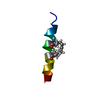
| |||||||||
|---|---|---|---|---|---|---|---|---|---|---|
| 1 |
| |||||||||
| NMR ensembles |
|
- Components
Components
| #1: Protein/peptide |  / CUL-3 / CUL-3Mass: 2386.830 Da / Num. of mol.: 1 / Fragment: UNP residues 49-68 / Source method: obtained synthetically Details: peptide was obtained on solid phase by Fmoc strategy Source: (synth.)   Homo sapiens (human) / References: UniProt: Q13618 Homo sapiens (human) / References: UniProt: Q13618 |
|---|
-Experimental details
-Experiment
| Experiment | Method:  SOLUTION NMR SOLUTION NMR | ||||||||||||
|---|---|---|---|---|---|---|---|---|---|---|---|---|---|
| NMR experiment |
|
- Sample preparation
Sample preparation
| Details | Contents: 1 mM Cul349-68EN, trifluoroethanol/water / Solvent system: trifluoroethanol/water |
|---|---|
| Sample | Conc.: 1 mM / Component: Cul349-68EN-1 |
| Sample conditions | pH: 3 / Pressure: ambient / Temperature: 298 K |
-NMR measurement
| NMR spectrometer | Type: Varian INOVA / Manufacturer: Varian / Model : INOVA / Field strength: 500 MHz : INOVA / Field strength: 500 MHz |
|---|
- Processing
Processing
| NMR software |
| ||||||||||||
|---|---|---|---|---|---|---|---|---|---|---|---|---|---|
| Refinement | Method:  simulated annealing / Software ordinal: 1 simulated annealing / Software ordinal: 1 | ||||||||||||
| NMR representative | Selection criteria: minimized average structure | ||||||||||||
| NMR ensemble | Conformer selection criteria: structures with the lowest energy Conformers calculated total number: 100 / Conformers submitted total number: 20 / Maximum lower distance constraint violation: 0 Å / Maximum upper distance constraint violation: 0 Å |
 Movie
Movie Controller
Controller



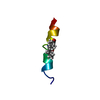
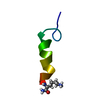







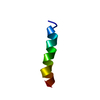
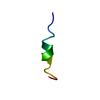
 PDBj
PDBj




